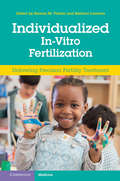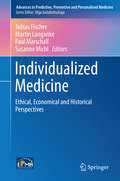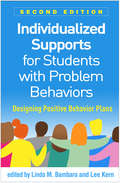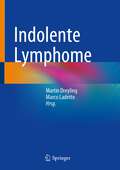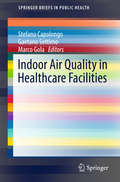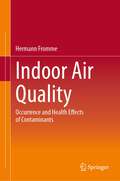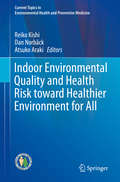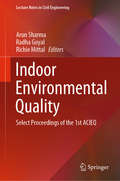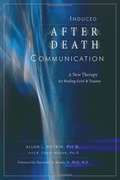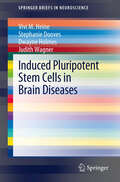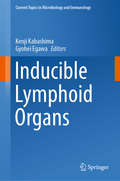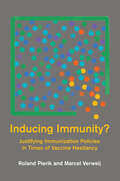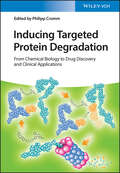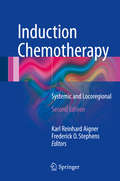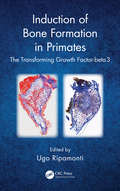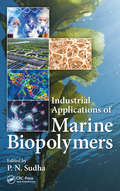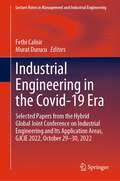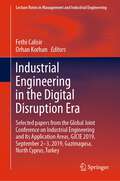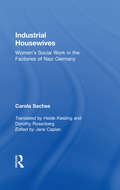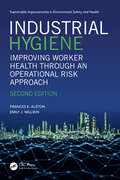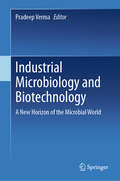- Table View
- List View
Individualized In-Vitro Fertilization: Delivering Precision Fertility Treatment
by Human M. Fatemi Barbara LawrenzThe increasing understanding of individual differences in response to in-vitro fertilization (IVF) treatment, resulting from genetic and ethnical differences, has increased the potential for individualized treatment for patients, resulting in improved pregnancy and live-birth outcomes. This illustrated book summarizes, and provides updates on, the most recent developments in individualized infertility treatment and embryo selection techniques. Individualization is not only confined to the different steps in the ovarian stimulation process and the luteal phase support, but also to embryo selection techniques, which include, among others, the analysis of embryo development pattern and genetic testing. Chapters cover a multitude of topics, ranging from oocyte maturation and immunological testing to fertilization technique in the IVF laboratory and preparation for optimal endometrial receptivity in cryo cycles. Essential reading for IVF specialists and embryologists in IVF Clinics and also an important text for medical consultants specializing in reproductive medicine, gynecology and embryology.
Individualized Medicine
by Martin Langanke Tobias Fischer Paul Marschall Susanne MichlIn 2009 the University Medicine Greifswald launched the "Greifswald Approach to Individualized Medicine" (GANI_MED) to implement biomarker-based individualized diagnostic and therapeutic strategies in clinical settings. Individualized Medicine (IM) has led not only to controversies about its potentials, but also about its societal, ethical and health economic implications. This anthology focusses on these areas and includes - next to clinical examples illustrating how the integrated analysis of biomarkers leads to significant improvement of therapeutic outcomes for a subgroup of patients - chapters about the definition, history and epistemology of IM. Additionally there is a focus on conceptual philosophical questions as well as challenges for applied research ethics (informed consent process, the IT-based consent management and the handling of incidental findings). Finally it pays attention to health economic aspects. The possibilities of IM to initiate a paradigm shift in the German health care provision are investigated. Furthermore, it is asked whether the G-DRG system is ready for the implementation of such approaches into clinical routine.
Individualized Supports for Students with Problem Behaviors, Second Edition: Designing Positive Behavior Plans (The\guilford School Practitioner Ser.)
by Linda M. Bambara Lee KernNoted for providing everything needed to develop individualized positive behavior support (PBS) plans for students with pervasive behavioral challenges, this authoritative guide has been revised and expanded to reflect 15 years of changes in the field. The book walks practitioners through the PBS process, emphasizing a team-based approach and presenting assessment procedures, intervention strategies, and guiding questions. Detailed case examples illustrate ways to meet the diverse needs of students across abilities, grade levels (PreK–12), and problem behaviors. In a convenient large-size format, the book follows the sequence of a typical PBS course, making it ideal for use in teaching and training. New to This Edition *Incorporates current tools and practices within an expanded, whole-school PBS approach. *Chapters on multi-tiered systems of support and the fundamentals of classroom management. *Chapter on writing, monitoring, and evaluating a complete PBS plan. *Two extended case examples that run through many of the chapters. *&“Commentaries from the Field&” in which leading experts reflect on the contributions, challenges, and future directions of PBS.
Indolent Lymphomas (Hematologic Malignancies)
by Martin Dreyling Marco LadettoThis book provides a comprehensive overview of current treatment strategies in indolent lymphomas, the clinical management of which continues to pose significant challenges for the general oncologist despite the tremendous progress in diagnosis, evaluation of risk factors, and molecular targeted approaches. Experts in the field from around the world describe the histomorphology in a clinically relevant manner, consider the role of risk factors in detail, and discuss the full spectrum of therapeutic approaches. Special emphasis is placed on the translation of molecular science into clinical care, and a disease-specific algorithm is proposed for each entity. The coverage encompasses follicular lymphoma, MALT, nodal marginal zone lymphoma, splenic marginal zone lymphoma, Waldenström’s macroglobulinemia, hairy cell leukemia, chronic lymphocytic leukemia, mycosis fungoides, large granular lymphocytic leukemia, and also mantle cell lymphoma. The book will be an excellent resource for experienced and inexperienced practitioners alike.
Indolente Lymphome
by Martin Dreyling Marco LadettoDieses Buch bietet einen umfassenden Überblick über die aktuellen Behandlungsstrategien bei indolenten Lymphomen, deren klinische Behandlung den Allgemeinonkologen trotz der enormen Fortschritte bei der Diagnose, der Bewertung von Risikofaktoren und molekularen zielgerichteten Ansätzen weiterhin vor große Herausforderungen stellt. Experten auf diesem Gebiet aus aller Welt beschreiben die Histomorphologie in klinisch relevanter Weise, gehen detailliert auf die Rolle der Risikofaktoren ein und erörtern das gesamte Spektrum der therapeutischen Ansätze. Besonderer Wert wird auf die Umsetzung molekularwissenschaftlicher Erkenntnisse in die klinische Versorgung gelegt, und für jede Entität wird ein krankheitsspezifischer Algorithmus vorgeschlagen. Behandelt werden das follikuläre Lymphom, das MALT-Lymphom, das nodale Marginalzonen-Lymphom, das Milz-Marginalzonen-Lymphom, die Waldenström-Makroglobulinämie, die Haarzell-Leukämie, die chronische lymphatische Leukämie, die Mycosis fungoides, die großkörnige lymphatische Leukämie und auch das Mantelzell-Lymphom. Das Buch ist ein hervorragendes Hilfsmittel für erfahrene und unerfahrene Ärzte gleichermaßen.
Indoor Air Quality in Healthcare Facilities
by Stefano Capolongo Gaetano Settimo Marco GolaThis interdisciplinary guide offers background, research findings, and practical strategies for assessing and improving air quality in hospitals and other healthcare settings. Positing good air quality as critical to patient and staff wellbeing, it identifies disease-carrying microbes, pollutants, and other airborne toxins and their health risks, and provides localized interventions for reducing transmission of pathogens. Effective large-scale approaches to air quality control are also outlined, from green building materials to hygienic HVAC and air treatment practices. Its thoroughness of coverage makes this book a vital resource for professionals involved in every aspect of health service facilities, from planning and construction to maintenance and management. Among the topics covered: #65533; Existing guidelines in indoor air quality: the case study of hospital environments #65533; Analysis of microorganisms in hospital environments and potential risks #65533; Legionella indoor air contamination in healthcare environments #65533; HVAC system design in healthcare facilities and control of aerosol contaminants #65533; Assessment of indoor air quality in inpatient wards Indoor Air Quality in Healthcare Facilities imparts up-to-date expertise to a variety of professional readers, including hospitals' technical and management departments, healthcare facilities' chief medical officers, hospital planners, sport and thermal building designers, public health departments, and students of universities and schools of hygiene.
Indoor Air Quality: Occurrence and Health Effects of Contaminants
by Hermann FrommeThis book presents a comprehensive and detailed overview of indoor pollution, covering the main contaminants in the indoor environment – air and dust, the health aspects of exposure, and different possibilities for a risk assessment. The book outlines the chemical substances and physical and biological factors that occur more frequently indoors, which are of health significance, or for which only limited information on their occurrence indoors is available to date. It also provides guidance to identify where problems may arise in the future and where data is missing for a valid exposure and risk assessment as well as for consequent risk management. Written by a highly recognized and experienced medical expert in the field, the book starts with an introduction to the indoor environment, including topics such as indoor environmental quality and health, indoor climate, sampling of indoor pollutants, and measures to improve indoor air quality. The author then delves into the fundamentals of exposure assessment and special exposure indoor situations, followed by in-depth coverage of the health aspects, and indoor air occurrence of several substances such as volatile organic compounds, very volatile organic compounds, semi-volatile organic compounds, and particulate matters and fibers. Particular attention is given to bioaerosols like mold, microbial volatile organic compounds, mycotoxins, and viruses. Readers will also find chapters devoted to the main health aspects and indoor occurrence of inorganic gases, radon and metals, and smoking. The book closes with a chapter on risk assessment, in which readers will learn more about the basics of risk assessment, key points and processes of a health evaluation, and guidance for assessing indoor air contamination. This book is a unique compilation of the current worldwide exposure situation in private and public indoor spaces, and an important reference for researchers that are willing to assess the rising burden of disease and potential causes behind degraded indoor air quality. Scientists, students, and policymakers interested in the fields of medicine and environmental sciences will understand the appeal of this book.
Indoor Environmental Quality and Health Risk toward Healthier Environment for All (Current Topics in Environmental Health and Preventive Medicine)
by Reiko Kishi Dan Norbäck Atsuko ArakiThis volume discusses the effects of indoor air environment and pollution in modern buildings on human health. Highlighting epidemiological studies and the determining factors, it offers proposals for improving indoor air quality (IAQ) in different environments. Focusing not only on homes and offices, but also vehicles and aircrafts, it details practical methods of measuring and assessing indoor air quality. Written by pioneering researchers, Indoor Environmental Quality and Health Risk toward Healthier Environment for All is a valuable resource for both new and established researchers as well as students seeking a comprehensive overview of the facts on indoor air quality and health. Also is also of interest to hygiene experts in industry, occupational health and safety professionals, governmental public health sectors and school physicians.
Indoor Environmental Quality: Select Proceedings of the 1st ACIEQ (Lecture Notes in Civil Engineering #60)
by Arun Sharma Radha Goyal Richie MittalThis volume presents selected papers presented during the First Asian Conference on Indoor Environmental Quality (ACIEQ). The contents cover themes of indoor air quality monitoring and modeling; the influence of confounding factors like thermal comfort parameters, such as temperature and relative humidity with respect to different building types, e.g., residential, commercial, institutional; ventilation characteristics, lighting and acoustics. It also focuses on people's performance, productivity, and behavior with respect to their exposure to various indoor air pollutants and parameters influencing the overall indoor environmental quality. This volume is primarily aimed at researchers working in environmental science and engineering, building architecture and design, HVAC and ventilation, public health, and epidemiology. The contents of this volume will also be useful to policy makers working on occupational health and building codes.
Induced After Death Communication: A New Therapy for Healing Grief and Trauma
by Allan L. Botkin R. Craig HoganInduced After-Death Communication (IADC) is a new therapy for grief and trauma that has helped thousands of people come to terms with their grief by allowing them the experience of private communication with their departed loved ones. Botkin, a clinical psychologist, created the therapy while counseling Vietnam veterans in his work at a Chicago area VA hospital. Botkin recounts his initial accidental discovery of IADC during therapy sessions with Sam, a Vietnam vet haunted by the memory of a Vietnamese girl he couldn't save. During the session, quite unexpectedly, Sam saw a vision of the girl's spirit, who told him everything was okay; she was at peace now. This single moment surpassed months-years-of therapy, and allowed Sam to reconnect with his family. Since that 1995 discovery, Botkin has honed IADC and used it to successfully treat countless patients-the book includes dozens of case examples-and has taught the procedure to therapists around the country. Induced After-Death Communication is the inside story of a revolutionary therapy that will profoundly affect how grief and trauma are understood and treated.
Induced Effects Of Genotoxic Agents In Eukaryotic Cells
by Toby G. RossmanThis book provides an understanding of the consequences of induced proteins in the toxicological response of cells to chemical and radiation damage to DNA and will be helpful in creating proper mathematical models for extrapolation to low doses and assessing human exposure or cellular injury.
Induced Pluripotent Stem Cells in Brain Diseases
by Dwayne Holmes Judith Wagner Vivi M. Heine Stephanie DoovesBrain diseases can have a large impact on patients and society, and treatment is often not available. A new approach in which somatic cells are reprogrammed into induced pluripotent cells (iPS cells) is a significant breakthrough for regenerative medicine. This promises patient-specific tissue for replacement therapies, as well as disease-specific cells for developmental modeling and drug treatment screening. However, this method faces issues of low reprogramming efficiency, and poorly defined criteria for determining the conversion of one cell type to another. Cells contain epigenetic "memories" of what they were that can affect reprogramming. This book discusses the various methods to reprogram cells, the control and determination of cell identity, the epigenetic models that have emerged and the application of iPS cell therapy for brain diseases, in particular Parkinson's disease and Vanishing White Matter (VWM).
Inducible Lymphoid Organs (Current Topics in Microbiology and Immunology #426)
by Kenji Kabashima Gyohei EgawaThis book sheds new light on “inducible” lymphoid organs (ILOs): antigen presentation sites that are generated de novo in peripheral tissues under various pathogenic conditions. Accomplished immunologists demonstrate that the physiological role of these ILOs is completely different from that of central lymphoid organs, i.e., the lymph nodes or spleen. In addition to the central organs, the ILOs are considered essential structures for the efficient elicitation of adaptive immune responses in lesions.The respective chapters highlight examples from multiple sites, e.g. the skin, lung, intestinal tract, genital tract, the synovial membrane of the joints and artificial lymph nodes. Accordingly, readers will learn that ILO structure and function can vary substantially, depending on the context. Presenting the results of the latest immunological research, the book offers a fascinating and insightful read for both scientists and clinicians in the areas of infectious and immune-associated diseases.
Inducing Immunity?: Justifying Immunization Policies in Times of Vaccine Hesitancy (Basic Bioethics)
by Roland Pierik Marcel VerweijWhy immunization must be made mandatory in times of vaccine hesitancy, and how we can design and implement immunization policies in a practical, trustworthy, and democratic way.We live in perilous times when a significant number of citizens are either defiantly antivaccination or hesitant to accept vaccinations for themselves or for their children. In Inducing Immunity?, legal philosopher Roland Pierik and bioethicist Marcel Verweij, explore ways to regulate collective immunization in as democratic a manner as possible. Approaching the problem as a matter of a conflict between the responsibility of government to protect public health and the basic right to freedom of citizens, Pierik and Verweij argue that John Stuart Mill&’s harm principle—the idea that individuals should be free to act so long as their actions do not harm others—offers a strong basis for coercive immunization policies.Covering childhood immunization policies, as well as vaccination programs aimed at adult citizens, the authors argue that a coercive immunization policy in any liberal democracy must first satisfy the principle of proportionality. This leads them to an in-depth exploration of the role of exemptions, the nature of coercion, and the contents of vaccination programs. In the final part of the book, the authors also discuss the importance and scope of freedom of speech, given how the current spread of misinformation has undermined confidence in vaccines.Offering an in-depth analysis in bioethics and legal philosophy, Inducing Immunity? is a sensible and applicable guide for health professionals, policymakers, and academics alike on how we can—and must—do better with our immunization policies.
Inducing Targeted Protein Degradation: From Chemical Biology to Drug Discovery and Clinical Applications
by Philipp CrommInducing Targeted Protein Degradation Enables drug developers in academia and industry to expand the range of accessible drug targets through induced protein degradation Since the breakthrough of the PROTAC technology in 2015, targeted protein degradation has revolutionized drug discovery, enabling pharma companies to develop completely novel therapeutics. Inducing Targeted Protein Degradation is a timely guide to navigating the complexities of the subject and understanding its practical application, with an eye on expanding the druggable space. In Inducing Targeted Protein Degradation, readers will find the most recent information on: Cellular mechanisms of targeted protein degradation and current approaches to utilize these mechanisms for drug discovery A comparison of different induced degradation approaches, including PROTAC, molecular glues, LYTACs and ATTECs as well as additional post translational modifications Drug development aspects such as DMPK optimization and criteria for the selection of clinical candidates A discussion of the potential of targeted degradation for expanding the druggable space Inducing Targeted Protein Degradation will serve as a practice-oriented reference on induced protein degradation for drug discovery professionals and for researchers employing chemical biology approaches.
Induction Chemotherapy
by Frederick O Stephens Karl Reinhard AignerInduction chemotherapy, as part of an integrated plan of management for locally advanced cancers, is being practiced throughout the world, but frequently teams are unaware of the work being undertaken in other institutions. This book aims to present the full range of management techniques used in induction chemotherapy within one accessible volume. It provides up-to-date information on pioneering and cutting edge practices and documents the advantages of integrated treatment schedules. Patient selection is discussed, and each of the cancer types for which induction therapy has proved important is considered in detail. All who are responsible for the treatment of patients with locally advanced cancers will find this book to be an invaluable source of information. It will be particularly interesting for specialist oncologists aiming to set up fully comprehensive cancer centers and for health administrators wishing to learn about the benefits of establishing such centers in strategic locations.
Induction of Bone Formation in Primates: The Transforming Growth Factor-beta 3
by Ugo RipamontiThe effects of the bone morphogenetic proteins (BMPs) family on bone formation are well documented, but the transforming growth factor (TGF)-beta ( isoforms are much less studied. The product of 20 years of study, Induction of Bone Formation in Primates: The Transforming Growth Factor- sums up editor Ugo Ripamonti's research into the osteogenic a
Industrial Applications of Glycoside Hydrolases
by Smriti ShrivastavaThis book gathers selected studies on the industrial applications of glycoside hydrolases (GHs), presenting an updated classification of these enzymes, and discussing their structure, mechanisms, and various approaches to improve their catalytic efficiency. Further, it explains the various industrial applications of glycoside hydrolases in food, effluent treatment, biofuel production, and the paper and pulp industries. Lastly, the book provides a comparative analysis of glycoside hydrolases and discusses the role of metagenomics in the discovery of industrially important enzymes. As such it is a thought-provoking, instructive and informative resource for biochemists, enzymologists, molecular biologists and bioprocess technologists.
Industrial Applications of Marine Biopolymers
by P. N. SudhaIndustrial Applications of Marine Biopolymers presents different classes of marine biopolymers and their industrial applications, demonstrating the precious value of ocean resources to society. This timely volume discusses the exceedingly useful polymers derived from these materials that are biodegradable, biocompatible, and at times water soluble. Direct use or chemically modified forms of such biomaterials have many chemical sites, making them suitable for varied types of industrial applications. In addition, this book also addresses current global challenges of conservation, including extended drought conditions and the need for improved agricultural methods, together with new bio-medical developments. It is suitable for anyone who has an interest in the industrial applications of biopolymers.
Industrial Engineering in the Covid-19 Era: Selected Papers from the Hybrid Global Joint Conference on Industrial Engineering and Its Application Areas, GJCIE 2022, October 29-30, 2022 (Lecture Notes in Management and Industrial Engineering)
by Fethi Calisir Murat DurucuThis book gathers extended versions of the best papers presented at the Global Joint Conference on Industrial Engineering and Its Application Areas (GJCIE), held as a hybrid event on October 29–30, 2022, in/from Istanbul Technical University. Continuing the tradition of previous volumes, it highlights recent developments of industrial engineering at the purpose of using and managing digital and intelligent technologies for application to a wide range of field, including manufacturing, healthcare, e-commerce and sustainable development. A special emphasis is given to engineering methods and strategies for managing pandemics and reducing their adverse effects on businesses.
Industrial Engineering in the Digital Disruption Era: Selected papers from the Global Joint Conference on Industrial Engineering and Its Application Areas, GJCIE 2019, September 2-3, 2019, Gazimagusa, North Cyprus, Turkey (Lecture Notes in Management and Industrial Engineering)
by Fethi Calisir Orhan KorhanThis book gathers extended versions of the best papers presented at the Global Joint Conference on Industrial Engineering and Its Application Areas (GJCIE), held on September 2–3, 2019, in Gazimagusa, North Cyprus, Turkey. It covers a wide range of topics, including decision analysis, supply chain management, systems modelling and quality control. Further, special emphasis is placed on the state of the art and the challenges of digital disruption, as well as effective strategies that can be used to change organizational structures and eliminate the barriers that are keeping industries from taking full advantage of today’s digital technologies.
Industrial Housewives: Women's Social Work in the Factories of Nazi Germany
by Carola SachseFocusing on women and their work, this valuable historical study traces industrial social work from its inception through the Nazi period. Author Sachse provides an analysis of policies applied to women workers rather than developed by and for them--as an example of how social policy treats women. This thorough book examines the continuities and discontinuities of industrial social work, and assesses the effect on the industrial welfare system of developments within National Socialism. Within this framework the study examines the role of women in industrial social work and labor relations, the attitudes of various groups toward the proper relations between industry and government, and the well-documented relationship between industrialists and the German Labor Front (DAF), the organization that replaced the outlawed labor unions.
Industrial Hygiene in the Pharmaceutical and Consumer Healthcare Industries (Drugs and the Pharmaceutical Sciences)
by Casey C. CosnerThis volume is an update on the use of containment in the pharmaceutical industry and consumer healthcare. It serves to highlight how industrial hygiene acts as a driving force within these industries to reduce the risk of exposure to chemical and physical agents, particularly to powders and dusts, while taking all factors into account. The author emphasizes how this book is not designed to replace other texts on containment; rather, it will serve to show a practical approach of utilizing the technologies within the high-demand industries of pharmaceuticals and consumer healthcare. Features: Timely coverage of changes in process control technology for the phamaceutical industry, a dynamic area in terms of products and manufacturing processes Provides an update on the unique requirements of these industries and how they differ from others, for example the microelectronics or specialized chemicals industries Draws on the author's vast experience in the field of industrial hygiene and hazardous materials Presents a collection of unique situations in which industrial hygiene was implemented to resolve a variety of scenarios and did not interfere with quality issues Addresses current topics relating to industry evolution such as migration of therapies to higher potency, RiskMAP, new modalities in medicines and treatments, large molecule therapeutics and conjugates
Industrial Hygiene: Improving Worker Health through an Operational Risk Approach, Second Edition (Sustainable Improvements in Environment Safety and Health)
by Frances Alston Emily MillikinSociety has become more educated on the impacts on human health and environment, and there has been a noticeable decrease in the acceptance of this risk by workers and the public. However, to ensure a higher level of worker protection, a revised approach to industrial hygiene is needed focusing on risk-reduction. This second edition of Industrial Hygiene focuses on implementation of an industrial hygiene program, using a risk-based approach, in an operational environment. Key elements of this book include balancing the art and science of industrial hygiene, risk-based industrial hygiene approaches, recognizing, evaluating, and controlling workplace hazards, medical monitoring for workers, emergency response, training, and evaluating industrial hygiene programs. Updated concepts on leadership, emergency response and monitoring, management of industrial hygiene projects, and risk communication are addressed in this edition. The book incorporates the ISO 45001 standard, “Occupational Health and Safety,” into an industrial hygiene program, which further demonstrates a risk-based approach that is internationally recognized. This is an ideal read for any student, researcher, or practitioner in the fields of occupational health and safety, industrial hygiene, risk management, and hazard control. New case studies with proposed solutions underpin the learning, and the instructor resource pack comprising PowerPoint presentations, question bank, and resources to enhance learning are available in this edition for qualified textbook adoption.
Industrial Microbiology and Biotechnology: A New Horizon of the Microbial World
by Pradeep VermaThis book is a comprehensive guide for industrial bioprocess development, covering major aspects of microbial processes and their role in biotechnology. It provides a selection of hyperproducers, microbial products, and metabolic engineering strategies for industrial production. It covers high cell density cultivation techniques product formation kinetics measurement and limiting parameters in large-scale process development. The first and second section of the book focuses on biotechniques, including spectroscopic concepts of light, wave, and electromagnetic theory, as well as absorption, fluorescence, phosphorescence, infrared, and Raman spectroscopy. It also covers the basic principles, concepts, biological applications, and other advanced techniques. The third section emphasizes microbial inventions and improvements in bioprocess development. It covers microbial products and recent developments in fermentation technology and also includes information on metabolic engineering. The fourth section related to microbial inventions and bioprocesses which include platforms for recombinant gene expression, as well as the development of recombinant heterologous expression systems such as E. coli, yeast, mammalian and insect cells, and plant cells used as biofactories. The fifth section of the book focuses on microbial product waste management in extreme environments, biomass waste management, bio-pulping, bio-bleaching, textiles, biofuels, and animal feed production. The book aims to provide a multidisciplinary opportunity on all aspects of microbial biotechnology. It covers recent international developments that have renewed interest in industrial microbiology and biotechnology. The book is suitable for teachers, researchers, graduate and post-graduate students, environmentalists, microbiologists, and biotechnologists.
